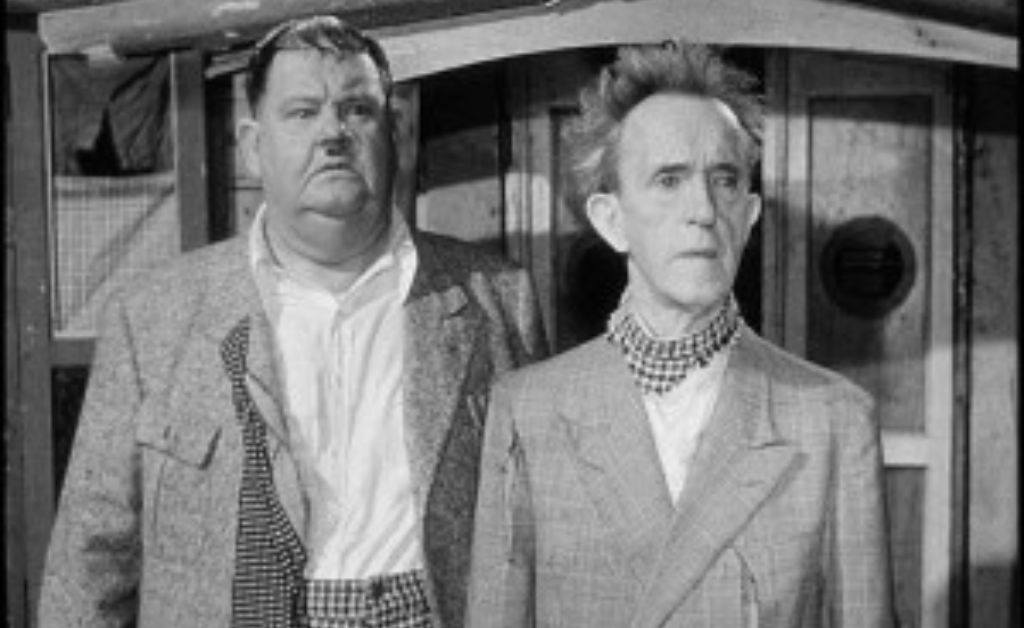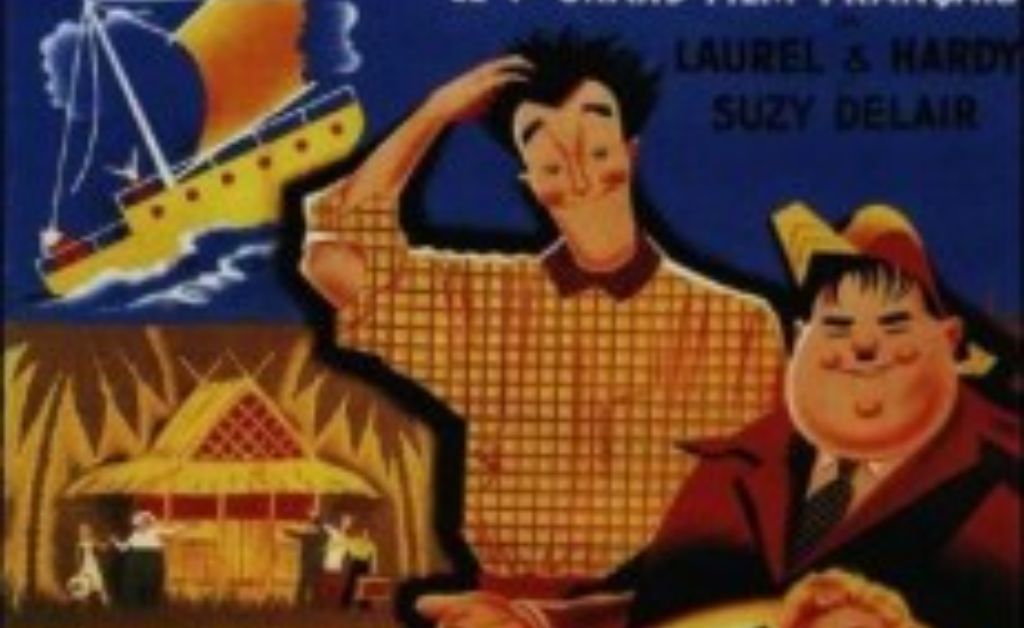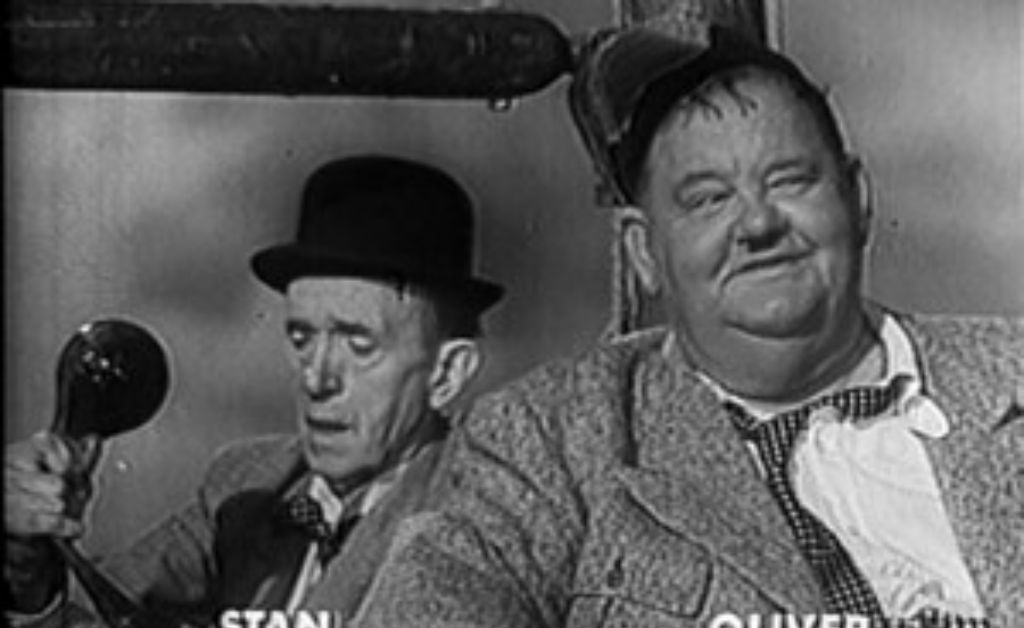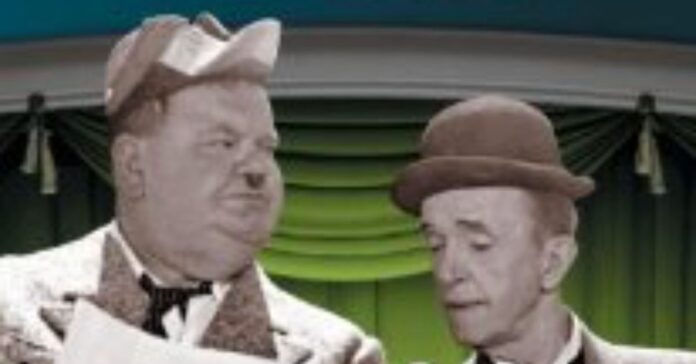In “The Final Film of Laurel and Hardy – A Study of the Chaotic Making and Marketing of Atoll K,” author Norbert Aping delves into the tumultuous production and promotion of the legendary comedy duo’s last film.
Through meticulous research and insightful analysis, the book offers a fascinating glimpse into the challenges faced by Laurel and Hardy during this period.
With a keen eye for detail, the author unravels the complexities of Atoll K’s creation, providing readers with a compelling narrative of Hollywood history.
The Final Film of Laurel and Hardy – A Study of the Chaotic Making and Marketing of Atoll K”
McFarland & Company, known for its unique and indispensable cinema publications, has a reputation for producing offbeat and essential film books.
I used to joke with a friend about imaginary titles that reflected McFarland’s quirky collection, such as “The Moon Voyage Films of Ray Harryhausen” or “The 2,341 Malaysian Films Beginning with the Letter ‘F’.”
However, some of these whimsical ideas, like “Smelly Movies: The Creation, Production, and Distribution of Mike Todd Jr. Smell-o-Vision,” sound intriguing enough to warrant a read!
One actual McFarland title that stands out is “The Final Film of Laurel and Hardy – A Study of the Chaotic Making and Marketing of Atoll K.”
Stan Laurel and Oliver Hardy, the iconic comedy duo, are adored worldwide for their work with producer Hal Roach.
Yet, a whole book dedicated to their disastrous final feature, a film even Laurel referred to as “an abortion,” may seem surprising.

Despite its reputation as a cinematic catastrophe that many loyal Laurel & Hardy fans refuse to watch, the book is captivating.
Although “Atoll K” undeniably suffers from various flaws, including Laurel’s deteriorating health during production, author Norbert Aping presents a nuanced examination of the film.
Contrary to popular belief, Aping argues that the movie is only partially devoid of merit. He highlights genuine Laurel & Hardy comedy moments reminiscent of their earlier works.
Furthermore, Aping meticulously documents the film’s development, troubled production, and complex release versions, offering readers an in-depth and almost day-by-day account of its creation.
The initial wave of Laurel & Hardy scholars, particularly the late John McCabe, categorically dismissed all films produced after 1940, following the duo’s departure from Hal Roach Studios in pursuit of what they hoped would be better opportunities at 20th Century Fox.
However, once they transitioned to Fox and subsequently to MGM for two additional films, Laurel was shocked to find that the creative freedom he cherished at Roach was severely restricted at both studios.
The eight features produced during this period and the subsequent “Atoll K” were summarily disregarded as inferior works and scarcely discussed in the early literature on Laurel & Hardy’s careers.

However, releasing these Fox (and later MGM) films on DVD in 2006 prompted a perfunctory reevaluation, revealing that some long-maligned movies were not as dreadful as previously believed.
While the initial Fox releases, “Great Guns” (1941) and “A-Haunting We Will Go” (1942), left much to be desired, the subsequent MGM entries, “Air Raid Wardens” (1943) and “Nothing But Trouble” (1944), were arguably even worse, the Fox films gradually showed improvement.
“Jitterbugs,” “The Dancing Masters” (both 1943), “The Big Noise” (1944), and “The Bullfighters” (1945), while not cinematic masterpieces, were on par with some of the duo’s weaker Roach features.
Unlike earlier Roach productions like “Bonnie Scotland” (1935) and “Swiss Miss” (1938), which were burdened with romantic subplots, musical interludes, and Roach’s aspirations for A-feature status, these later Fox films wisely focused on Laurel & Hardy’s pure comedic antics.
Despite this, the duo left Fox after 1945, mistakenly assuming their modest yet profitable films would secure their work elsewhere.
However, the rapidly changing landscape of the postwar film industry left Laurel & Hardy, already deemed “old-fashioned” comedians even in the 1930s, all but obsolete in Hollywood’s eyes.
However, hungry for comedy, Europe had noticed Laurel & Hardy. Following the war, their older films were re-released, and even their newer productions were warmly embraced.
They embarked on highly successful tours of British music halls, where they were greeted with adoration and mobbed wherever they appeared.

Given their immense popularity in Europe, it seemed like a sure bet to produce a French-Italian collaboration starring Laurel & Hardy.
Although Aping’s book does not delve deeply into speculation on this matter, one can reasonably assume that if “Atoll K” had been a satisfying and rewarding project for the duo, they might have enjoyed a brief but fruitful second career making one or two films per year in Europe until Hardy’s premature passing.
Unfortunately, “Atoll K” was cursed from the start despite its substantial budget, equivalent to the combined production costs of all the duo’s previous Roach films.
Aping meticulously details the myriad issues that plagued the production, including the involvement of multiple screenwriters working in three languages.
(English for Laurel & Hardy’s scenes, and French and Italian for the rest), each pursuing their comedic agendas, including elements of political satire that didn’t align with the duo’s style.
Additionally, the director, Léo Joannon, proved to be entirely out of step with their brand of humor, earning notoriety for his eccentricities, such as donning a pith helmet and armed with various megaphones.
Furthermore, the duo’s physical health became a significant concern during production. While Hardy had never been more prominent, his weight didn’t hinder his comic timing.
On the other hand, Stan Laurel’s health took a drastic turn for the worse. In the initial location footage, he appeared older but relatively fit.
However, as filming progressed, particularly during studio scenes, he exhibited signs of extreme weight loss and weakness, resembling a man recently liberated from a concentration camp.
Standing at 5’8″, Laurel’s weight plummeted to a mere 115 lbs. at one point. His shocking physical deterioration became a distressing and unavoidable distraction, even in some of the duo’s finest scenes, detracting from the audience’s enjoyment of the film.
Aping’s book represents movie archaeology at its finest. Faced with the challenge of most of the cast and crew being deceased or unavailable for interviews, he extensively utilized surviving archival documents, which surprisingly were abundant.
For instance, he meticulously examines each version of the treatment and screenplay, carefully weighing their strengths and weaknesses.
Furthermore, he provides thorough analyses of the various final edits of the film, encompassing different language cuts, including French, Italian, German, and two distinct English versions.
On a broader scale, “The Final Film of Laurel and Hardy” offers detailed insights into the duo’s activities during pre-production and filming, particularly amidst the numerous prolonged delays.
It vividly portrays their experiences as they wait in Paris and travel to Italy to promote the film.
Other books have explored aspects of Laurel & Hardy’s careers, such as their music hall performances in Britain, their final appearances on the American television show “This Is Your Life,” and their preparations for an unrealized television series.
Aping’s book sheds light on a significant chapter of their later lives that had not been extensively documented before.
As someone who has always held a fondness for or been intrigued by substantial portions of “Atoll K,” by the book’s conclusion, I found myself yearning for a complete restoration of the best available version of this now-public domain film.
The most widely accessible version in America, “Utopa,” is compromised by several significant cuts, undermining its integrity.
Until such a restoration is realized, Norbert Aping’s “The Final Film of Laurel and Hardy” explores this long-disparaged yet fascinating film.

